AdventureSmith Explorations Founder and President Todd Smith reviews his Explora Rapa Nui stay on Chile’s Easter Island.
Rapa Nui is remote. Very remote. It is among the most remote inhabited islands in the world, and this isolation permeates everything about the island, its people and the mysterious statues, called moai, that travelers come here to see.
Rapa Nui is the Polynesian name for Easter Island. The small island measures about 15.3 miles long by 7.6 miles wide. The island forms the southeastern point of the Polynesian triangle and seems more Polynesian than Chilean.
Travel to Rapa Nui requires a 5 hour flights from Santiago, the capital of Chile. On most days there are two round-trip flights on LAN Airlines. Once each week the flight continues to Pape’ete, Tahiti, making it possible to do an Easter Island stopover on your way to or from the South Pacific. I recommend arriving on the early flight. Arriving on the early flight gives you a half day to explore when you arrive, and because of the remote location this allows for a wonderful introduction to the island.
Upon arrival I was greeted by the transfer vans that play a critical role in the exploration of the island. The airport is tiny—but with a huge runway built as an emergency landing site for NASA space shuttles. Upon arrival at the Explora Rapa Nui Lodge, I was shown to my room before attending an informative orientation outlining the activities available for the week.
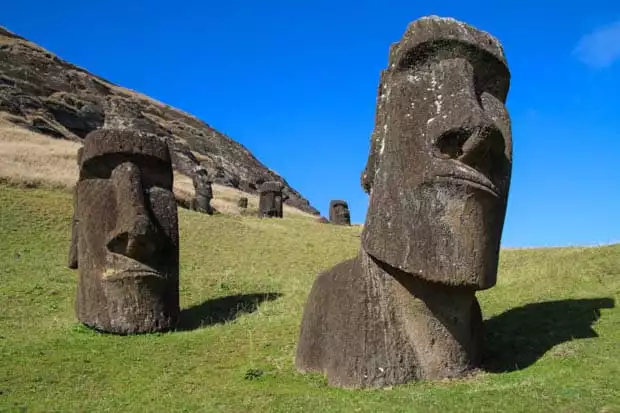
Rano Raraku
My excursion the first afternoon explored Rano Raraku, commonly known as the quarry. This is the dramatic volcanic mountainside where the moai, or large stone statues that the islands are so famous for, are carved or born. On the road to Rano Raruku my group excitedly peered out the window soaking in the dramatic green landscape contrasted by the vivid blue water. We scanned the passing landscape for moai. Signs of archeology are seemingly everywhere and soon we saw crumbling platforms, walls and sure enough fallen broken moai. Our route cut through green grassy hills that led to black rocky cliffs towering over a brilliant blue ocean. It was a stunning sunny day. We turned from the main road and in front of us was an otherworldly sight. The lush fields flanked a dramatic rock cone, and dotted among the carpet of green were the huge stone statues we came to see.
Our guide pointed out moai in the mountain, half carved.
As we pulled into the parking lot our small group was falling over ourselves to get out of the van and hurry to this spiritual site. The first kilometer is one of the most dramatic on the entire island with moai of all shapes and sizes, standing and fallen, overlooking their island. Our guide pointed out moai in the mountain, half carved. He explained the latest archeological understandings of how the ancient Rapa Nui people, with only stone tools, carved these giant monoliths. The average moai stands 13 feet tall and weighs 14 tons. We began to gain an understanding and appreciation for the magnitude of this unfathomable undertaking. Moai seemed to stare through us toward the past as if to say you will never understand who we are or how we became here.
Rounding a corner of the quarry we were surprised by another incredible site. In the distance and framed by a stunning azure sea were 15 moai staring inland back at us. Unlike the scattered statues at the quarry these are arranged in a perfect line like chess pieces ready to battle. Though we were eager to take off cross country, our guide explained that we would have a chance to see them up close later in the week.
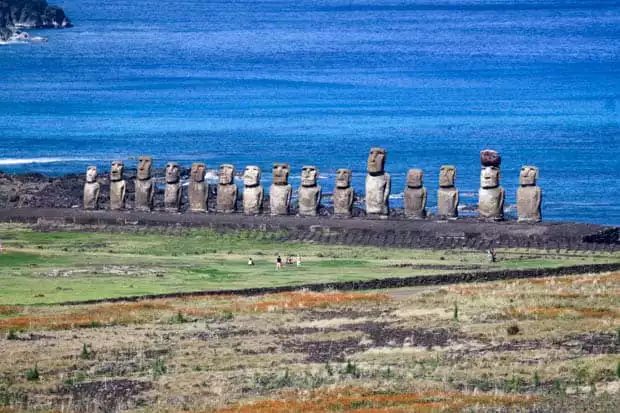
After having a few moments on our own to wander and take pictures, our guide rounded us up to show us another site. Up a short trail from the quarry was the crater itself and a walk over a slight rise revealed a beautiful round lake surrounded by green grassy slopes with scattered moai peering down at the sacred waters just as we were. The entire experience was surreal and we drove back to the lodge in silence, lost in our own thoughts.
Activity Options at Explora Rapa Nui
Guided active explorations are at the heart of the Explora experience, and at Rapa Nui there are over 20 different options to choose from. Upon arrival guests receive a private consultation with a knowledgeable guide to review the activity options and outline a personal schedule for the week. Sitting at a small table with a large map of the Island under glass, your guide uses a pen to write right on the table and based on your interests and ability craft a schedule custom to you. There are easy guided walks and van-supported sightseeing, moderate hikes that reach beyond the roads and crowds to explore lesser-known but equally spectacular sites, and longer full-day expeditions that will challenge even the most adventurous traveler. One guide on my trip was a veteran, imported from Explora’s other lodges in mainland Chile. But all the others were locals born and raised in Rapa Nui. Their vast knowledge, unique insights and proud heritage provide the foundation upon which the entire immersive experience is built at Explora. They are the reason to book this trip over other options in the region.
Explora Rapa Nui Lodge Review
The food and architecture at the lodge are, like so many other things, intertwined with local history and culture. Meals are served with 180-degree views across the island to the sea. Locally sourced fish, meat and produce from the organic garden are prepared by talented chefs with delightful presentations that would impress even the most discriminating luxury traveler. They even baked me a special cake when the staff learned it was my birthday.
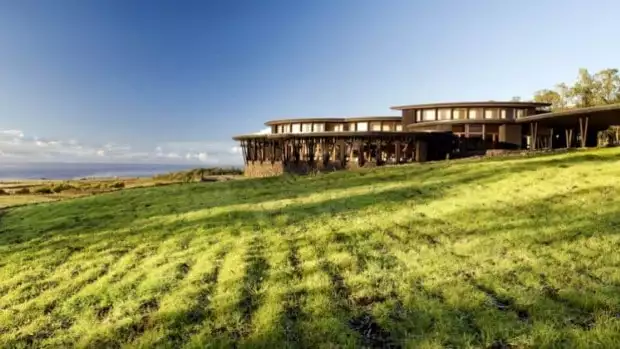
The lodge itself is LEED Certified (Leadership in Energy and Environmental Design) and designed to resemble a traditional stone long house with oval lines and local wood highlighted throughout. Twenty-six rooms and four suites, all with ocean views, are set along easy paths from the main lodge. Choose the rooms closest to reception for the easiest commute to lodge. Keeping with the philosophy of disconnection, televisions and WiFi are only available in the hotel’s common areas. Each room has an ocean view, with a simple relaxing aesthetic. My room was remarkably quiet and really captured the solitude of the place. The lodge features the restaurant, a huge bar and lounge, a guide’s area, gift shop, theater for lectures, a pool, spa, reception area and a store with a surprising selection of gear in case you forgot something. A water, sunscreen and snack station is always at the ready to hydrate, protect and fuel you for the day’s adventures.

Otongo Volcano & Ahu Tongariki
On my first full day I opted for two half-day activities including the Otongo Volcano crater hike and Ahu Tongariki, also known as The Fifteen. The Otongo Volcano hike begins and ends with archeological sites, and while it does include considerable cultural elements is illustrative of the nature-based activities included in a visit to Rapa Nui. These natural wonders surprised me as I imagined most of the experience would be focused on the island’s famous statues. The hike began at Ahu Tahira, a dramatic example of fallen moai, which to me were nearly as intriguing as the standing ones. In fact, at the time of Rapa Nui’s “discovery” by Europeans on Easter Sunday 1722, all the moai were fallen. Only in modern times have they been restored to their original standing position. From Ahu Tahira the hike slowly ascended along a dramatic cliff overlooking a spectacular and rugged coastline. We climbed past horses and cows, which seemed to outnumber residents on this isolated outpost. As we ascended, it was difficult to fathom just how far away from civilization we were. Our gazes southeast were over a stretch of water unbroken for roughly 4,000 miles until reaching Antarctica.

The Otongo Crater was the site of the famed birdman contest, in which the chiefs of each local clan would compete to swim, scale a rocky islet and bring back the first sooty tern eggs of the season.
We finally reached the crater rim and were again overwhelmed by the beauty of the crater and coast below. A sweeping view overlooked the Otongo Crater and we stopped a few moments to take it all in. As we proceeded around the crater rim our guides explained the strange birdman cult and contest, which arose during the troubled times after European contact. Offshore is a small archipelago of rocky islets that are home to numerous seabirds including sooty terns. During the times of the birdman contest the chiefs of each local clan or their representative would compete to bring back the first eggs of the season. The men would climb down the steep slope of the crater scaling the rocky cliffs below. Somehow they would navigate the pounding surf and swim 2 kilometers to the farthest islet. There they would scale the cliff walls, hide on the island for hours or days, until the first egg was laid and collected. Then they would swim, with the egg intact, back to the main island, ascend to the crater rim and run to the nearby village to deliver the prize. The winner, or his leader, became chief of the entire island for the year.
After walking around the rim of the crater, with fantastic views of the crater lake, coast and the main town of Hanga Roa below, we arrived at Rano Kao. Here there is a visitor center and recreated traditional houses to learn how the Rapa Nui people lived on the island for centuries before contact. The site was crowded with a dozen or so tourists, which was quite a contrast to the solitude of the walk we had just enjoyed. Soon the Explora van arrived and we headed back to the lodge for a well-deserved lunch.
Ahu Tongariki – The Fifteen
After lunch was the excursion we most looked forward to. Ahu Tongariki, or commonly known as The Fifteen, is the largest archeological site in Polynesia and a highlight of any trip to Rapa Nui. It is difficult to comprehend the scale of this monument and the manpower, engineering and organization it took to build such a place. Our group instantly scattered, eager to take photos, soak in the ocean view and explore. Guides were available to answer questions, but mostly we were free to discover on our own. On our way back to the lodge we visited the strange, perfectly round and magnetically charged rocks at Te Pito Kura, which are unlike any other archeology on the island. Our last stop was at Playa Anakena, the site of the first landing of Rapa Nui people on the island. Swimming from a white-sand beach in the cool blue waters with moai towering above while the sun set was a fitting end to an extraordinary day.
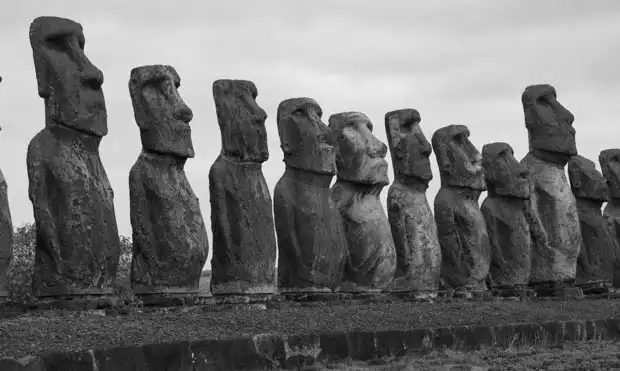
Hanga Roa, Ahu a Kiva & Caves
The next day I chose to visit the town of Hanga Roa. Unlike every other lodge or hotel on the island, the Explora lodge is secluded, and one could visit without ever experiencing town. We visited the museum and a tourist market, but our group was clamoring for more authentic crafts. After a visit to the Catholic church, waterfront and town square our guide led us to the shop of a local artisan famous for his beautiful wood carvings and faithful recreations of original Rongo Rongo, or Rapa Nui storyboards. Even in town we were treated to treasures we would never have found if it weren’t for the Explora guides.

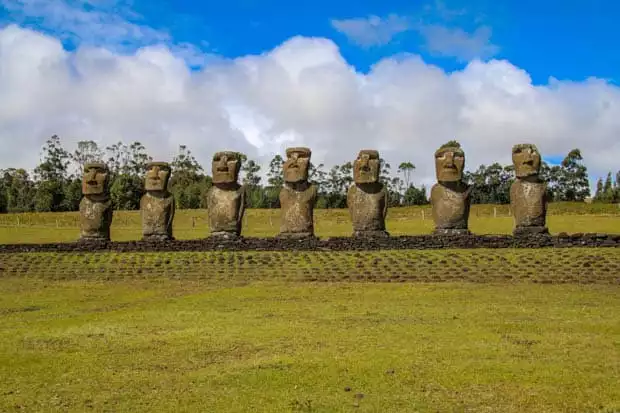
Legend has it they are the seven scouts sent to the island and they are watching for the return of their king.
After lunch we visited Ahu a Kivi, or The Seven, unique because of their positioning gazing out to sea. Legend has it they are the seven scouts sent to the island and they are watching for the return of their king. From here we began one of the most amazing hikes through lava caves and to the coast. Again we had to make our way through a large tour group at the entrance of a cave, and they stood in wonder as we turned our headlamps on and disappeared into the darkness of the cave. Our guides lead an extraordinary trek through a lava tube and climb back into the light hundreds of meters away. We visited several such caves and learned how these caves were, and still are sacred to the locals. The final cave was the most incredible. We shimmied down a small entrance and walked a bit before we saw a light at the end of the tunnel. When we reached the light we realized it was not the way out, but a spectacular window opening a hundred feet above the crashing sea. The blue of the ocean and bright light were blinding to our cave-adjusted eyes and we sat overlooking the Pacific from a most spectacular perch.
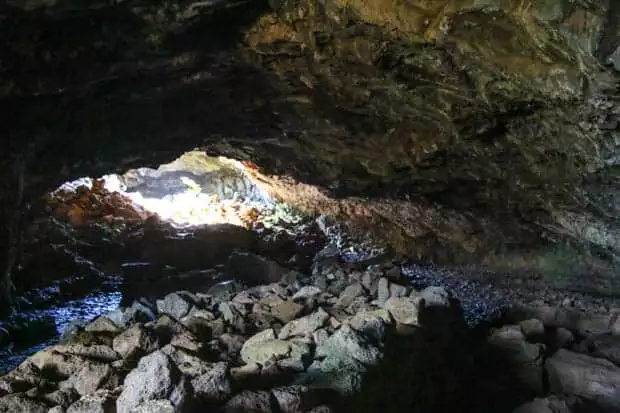
Returning out of the final cave we walked along the coast to a park near town where dozens of locals and travelers were gathering at Ahu Tahai. These moai have the white shell eyes that were once found in all moai. The moai were not considered complete or alive, until the eyes were set in place. We sat and watched the sunset behind the moai while our guide provided a snack of cheese, crackers and Champagne.
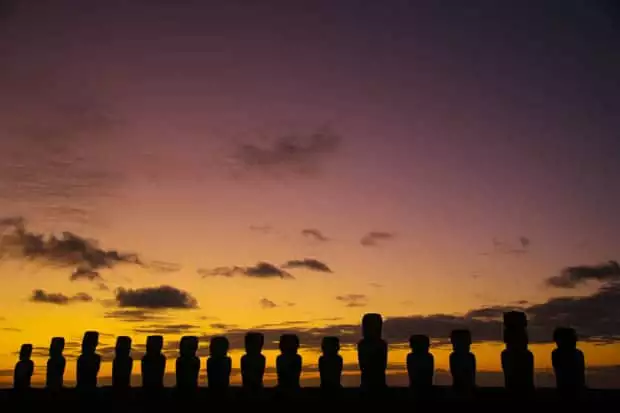
The next day I joined a small group of adventurous travelers for a hike to Maunga Tervaka, the highest point on the island. The walk was long but gentle and as we ascended we moved from the warm sunny lowlands to a foggy, breezy peak. By the time we summited we could hardly see our surroundings. The walk down felt good on our legs and skin and we soon warmed and enjoyed views over the entire islands. We ended at a remote beach where Explora had set up a traditional lunch of fish cooked on heated lava rocks. All Explora guests were there and we shared stories of our adventures as we dined overlooking the sea.
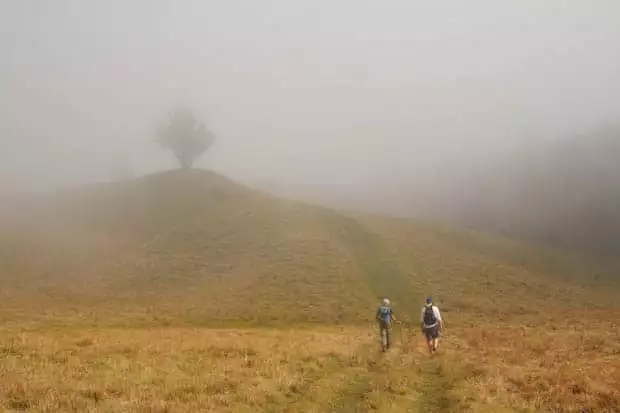
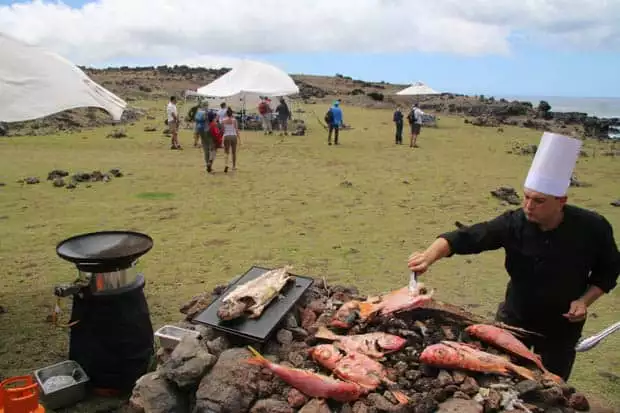
North Coast, Moto Nui Snorkeling & Ana Kai Tanata Cave
My final day was a challenge, and our group of hearty adventures had dwindled to only 4. Most guests chose easier, van-based explorations, whereas we chose the longest full-day hike available, traversing the unspoiled North Coast of the island. Like other walks this one had signs of archeology everywhere, but for the entire six hours, we didn’t encounter any other people. We saw the foundations of traditional stone homes, fallen moai, petroglyphs and “lithic mulch” or stones used in ancient agriculture. The hike ended with a swim at Playa Anakena, one of the most rewarding activities of the trip. We returned to the lodge weary and satisfied.


On my final morning there was time to squeeze in one last activity, a snorkel trip. We visited the famous birdman islets of Moto Nui that I had viewed from the crater rim days earlier. The seas were rough and the water was cool, so the snorkel trip was short. But the extraordinary clear blue water was worth it. We also viewed the Ana Kai Tanata cave, which harbors cave paintings and is related to the mysterious birdman cult. Upon our return, our boatman surfed his skiff along with local surfers, catching the waves that seem to always pound the coast, and soon we were back at the dock. A quick transfer to the airport and I was transferred back to reality. As the plane departs I was overwhelmed, processing the incredible experiences of the past few days. I already longed to return to Rapa Nui, but don’t know if I ever will. But if this was my only visit I am glad I experienced it with Explora.
For more photos from my Explora Rapa Nui adventure, view my AdventureSmith Explorations Facebook album.
This Easter Island travel review was written by an AdventureSmith Explorations crew member. Contact one of our Adventure Specialists to learn more about our Chile tours: 1-877-620-2875.